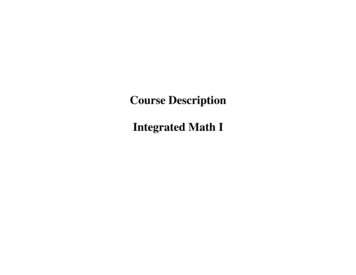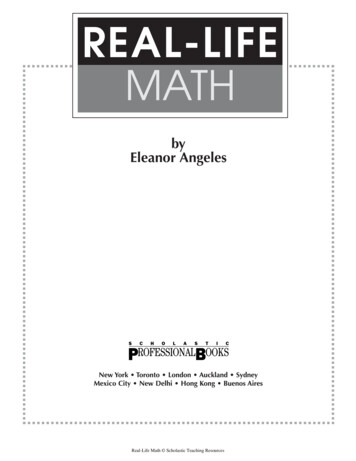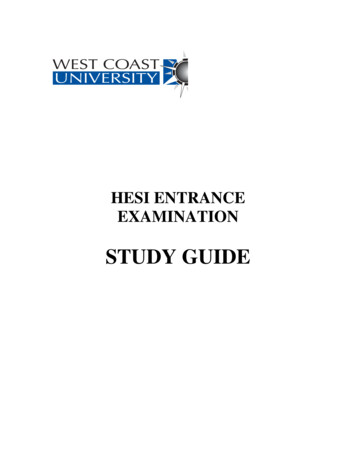
Transcription
Course DescriptionIntegrated Math I
Integrated Math ICourse Rationale:Integrated Math I is designed as an enhancement course for topics in secondary mathematics education. Topics introduced inIntegrated Math provide the foundation students require for future success in high school mathematics, critical thinking, andproblem solving. The primary goal in Integrated Math is to help students develop more concrete mathematical knowledge andapply this knowledge to applications represented in Missouri EOC assessment tests. The Integrated Math curriculum samplesfrom the diverse topics often found on the EOC, and places a special emphasis on developing a plan to understand and solvethese types of problems. In addition, the curriculum of Integrated Math will mimic and reinforce many of the topics students willsee in their Algebra I and Geometry studies at the secondary level.Course Description:Integrated Math I topics include recognizing and developing patterns using tables, graphs and equations. Mathematical modelingis stressed as a methodology for approaching the solution to problems. Students will explore operations on algebraicexpressions, and apply mathematical properties to algebraic equations. Students will problem solve using equations, graphs andtables and investigate linear relationships, including comparing and contrasting options and decision-making using algebraicmodels. Reinforcement of topics from two-dimensional Geometry is integrated into this curriculum. This includes applicationsfrom the areas of area and perimeter, the Pythagorean Theorem and its applications, as well as geometric proportion. Finally,introductory instruction in the area of mathematical probability is provided to reinforce use of fractions and numerical modeling.Technology will be used to introduce and expand upon the areas of study listed above.13
Resources:Adopted Text:Websites:www.dese.mo.gov/Classroom Assessment Item nication ArtsMAMathematicsSCScienceSSSocial StudiesCLENOARGSRMDPCourse Level ExpectationsMath StrandsNumber and OperationsAlgebraic RelationshipsGeometric Spatial RelationshipsMeasurementsData and Probability14BTKCApAnSEBloom’s ynthesisEvaluation
Integrated Math INumber and Operations1. Understand numbers, ways of representing numbers, relationships among numbers and number systems.Measurable LearnerObjectiveThe student will be able to:Read, write and comparenumbers Compare and orderrational and irrationalnumbers, includingfinding theirapproximate locationson a number lineAssessedShow-MeGoalsMA 53.31.6CLECodeBTNO1.AApInstructional Strategies/StudentActivities/ Resources Students will compare and orderrational and irrational numbers duringthe “Line Up Cards” ActivityAttachment A The students will compare and orderrational and irrational numbers whencompleting the following itchFraction SwitchDecimal Challenge15Assessments (includingPerformance-based)Students will use rational andirrational numbers, includingfinding their approximate locationson a number line with a textbookassignment.MasteryMin. %75%
Number and Operations2. Understand meanings of operations and how they relate to one anotherMeasurable LearnerObjectiveThe student will be able to:Describe effects ofoperations Describe the effects ofoperations, such asmultiplication, division,and computing powersand roots on themagnitude of quantitiesAssessedShow-MeGoalsMA 53.44.1CLECodeBTInstructional Strategies/StudentActivities/ ResourcesAssessments (includingPerformance-based)NO2.B.9C The students will complete a variety ofactivities to describe the effects ofoperations on quantities.Students will describe the effectsof operations, such asmultiplication, division, andcomputing powers and roots onthe magnitude of quantities with atextbook assignment.Attachment B (4 pages) The students will work describeoperations on radicals when completingan on-line lesson and assessmentincluding the game “MillionaireRadicals.”www.regentprep.org/Math A#3 OperationsOperations on RadicalsIntegrated Skills:16MasteryMin. %80%
Number and Operations2. Understand meanings of operations and how they relate to one anotherMeasurable LearnerObjectiveThe student will be able to:Apply properties ofoperations AssessedShow-MeGoalsMA 41.61.10Apply properties ofexponents (includingorder of operations) tosimplify expressions orsolve equationsCLECodeBTNO2.C.9ApInstructional Strategies/StudentActivities/ Resources*Attachment C – Tale of Exponents The students will apply order ofoperations in a classroom activity. Theteacher will give the students 5numbers that they will use to createthree problems. The problems musthave three or more operations, or twoor more operations and parentheses.At least one problem must involve anexponent and each solution must havea different value.Submitted by: Serita Hanson, LickingON-LINE ACTIVITY: “Easy ted Skills: Workplace Readiness17Assessments (includingPerformance-based)Students will apply properties ofexponents to simplify expressionsor solve equations withconstructed response questions.Attachment D (2 pages)MasteryMin. %75%
Number and Operations2. Understand meanings of operations and how they relate to one anotherMeasurable LearnerObjectiveThe student will be able to:Apply operations on realand complex numbers Apply operations to realnumbers, using mentalcomputation or paperand-pencil calculationsfor simple cases andtechnology for morecomplicated casesAssessedShow-MeGoalsMA 1MA 4MA 51.43.4CLECodeBTInstructional Strategies/StudentActivities/ ResourcesNO2.D.9-10Ap The students will apply operations toreal numbers when completing theSuccessLink lesson “Fantastic Buy?”Assessments h, High SchoolStudents will apply operations toreal numbers, using mentalcomputation or paper-and-pencilcalculations for simple cases andtechnology for more complicatedcases with a variety of quizzes. The students will apply operations toreal numbers when completing thegame “Power Up h9/gradenine.htmAttachment EIntegrated Skills:18MasteryMin. %75%
Number and Operations3. Compute fluently and make reasonable estimates.Measurable LearnerObjectiveThe student will be able to:Compute problems Apply all operations toreal numbersAssessedShow-MeGoalsMA 11.103.3CLECodeBTNO3.C.9ApInstructional Strategies/StudentActivities/ Resources The students will apply all operationsto real numbers when completing online activities at the following 1668.htmlwww.quia.com/jg/1666.html Students will apply all operations whencompleting a Successlink lesson “ALook Into Beginning a NewBusiness”www.successlink.orgIntegrated Skills: Workplace Readiness19Assessments (includingPerformance-based)Students will apply all operationsto real numbers with a textbookassignment or a constructedresponse question.www.dese.mo.gov/Classroom Assessment Item BankConstructed ResponsePainting JobMasteryMin. %75%
Number and Operations3. Compute fluently and make reasonable estimates.Measurable LearnerObjectiveThe student will be able to:Estimate and justifysolutions AssessedShow-MeGoalsMA 13.8Judge thereasonableness ofnumerical computationsand their resultsCLECodeBTNO3.D.9-12EInstructional Strategies/StudentActivities/ ResourcesAssessments (includingPerformance-based) The students will judge thereasonableness of numericalcomputations and their results whencompleting the performance event“Making a Monthly Budget”.Students will judge thereasonableness of numericalcomputations and their resultswith the completion of EOC likequestions.www.dese.mo.gov/Classroom Assessment Item BankPerformance Eventwww.successlink.orgSample MAP Questions Relatedto Discrete MathIntegrated Skills: Workplace Readiness20MasteryMin. %80%
Number and Operations3. Compute fluently and make reasonable estimates.Measurable LearnerObjectiveThe student will be able to:Use proportionalreasoning Solve problemsinvolving proportionsAssessedShow-MeGoalsMA 1MA 43.32.1CLECodeBTInstructional Strategies/StudentActivities/ ResourcesNO3.E.9-12Ap The students will solve problemsinvolving proportions of the GoldenRectangle.Attachment F The students will solve a probleminvolving proportions involving thecharacter in the book Gulliver’s TravelsAttachment GIntegrated Skills: Workplace Readiness21Assessments (includingPerformance-based)Students will solve problemsinvolving proportions on aconstructed response question,and give an oral presentationabout a problem solving activity toclassmates.www.dese.mo.govClassroom Assessment Item BankPolygonsMasteryMin. %80%
Algebraic Relationships1. Understand patterns, relations and functionsMeasurable LearnerObjectiveThe student will be able to:Create and analyzepatterns AssessedShow-MeGoalsMA 41.63.5Generalize patternsusing explicitly orrecursively definedfunctionsCLECodeBTInstructional Strategies/StudentActivities/ ResourcesAR1.B9-12C The students will work in groups of twowith unifix cubes (snap cubes) togeneralize patterns. Students will drawa pictorial and create a chart that showsthe data concerning the perimeter andarea of 1, 3, 5, 7, and 9 cubes (inwhatever formation the students’ wish).Students will then create an equation toshow the pattern that is shown for boththe perimeter and area. Students willcommunicate their findings with theclass. The class will evaluate andanalyze the different findings The students will work with Pick’sTheorem to generalize patterns whilefinding the area of a triangle.“Investigating Pick’s Theorem”http://illuminations.nctm.orgLessons, Grades 9-12Integrated Skills: Workplace Readiness22Assessments (includingPerformance-based)Students will generalize patternsusing explicitly or recursivelydefined functions with aworksheet.Attachment H (3 pages)MasteryMin. %75%
Algebraic Relationships1. Understand patterns, relations and functionsMeasurable LearnerObjectiveThe student will be able to:Classify objects andrepresentations AssessedShow-MeGoalsMA 41.6Compare and contrastvarious forms ofrepresentations ofpatternsCLECodeBTAR1.C9-12AInstructional Strategies/StudentActivities/ Resources The students will compare andcontrast various forms of real life datarepresentations when completing 9lessons in the unit “Least SquaresRegression” located at the ons, Grades 9-12 The students will compare andcontrast various forms of patterns in aSuccessLink lesson “Fibonacci ArtMath in Design”www.successlink.orgIntegrated Skills: Workplace Readiness23Assessments (includingPerformance-based)Students will compare andcontrast various forms ofrepresentations of patterns on atextbook assignment or thefollowing worksheet.Attachment IMasteryMin. %80%
Algebraic Relationships1. Understand patterns, relations and functionsMeasurable LearnerObjectiveThe student will be able to:Identify and comparefunctions Understand andcompare the propertiesof linear andexponential functions(include intercepts)AssessedShow-MeGoalsMA 41.63.6CLECodeBTAR1.D9CAInstructional Strategies/StudentActivities/ Resources The students will understand andcompare the properties of linear andexponential functions when usinggraphs, tables, number lines, verbaldescriptions, and symbols to representthe domain of various functions.“Domain ns, Grades 9-12Activities: “Simple Plot” and egrated Skills: Technology24Assessments (includingPerformance-based)Students will understand andcompare the properties of linearand exponential functions with aconstructed response question.Graphing Linear Equationswww.dese.mo.govClassroom Assessment Item BankMasteryMin. %80%
Algebraic Relationships1. Understand patterns, relations and functionsMeasurable LearnerObjectiveThe student will be able to:Describe the effects ofparameter changes AssessedShow-MeGoalsMA 41.84.1Describe the effects ofparameter changes onlinear functionsCLECodeBTAR1.E.9CInstructional Strategies/StudentActivities/ ResourcesAssessments (includingPerformance-based) The students will describe the effectsof parameter changes on linearfunctions during the classroom activity“Hiking”Students will describe the effectsof parameter changes on linearfunctions when completing aperformance activity.Attachment JAttachment KAnd/or a worksheetAttachment LIntegrated Skills: Workplace Readiness25MasteryMin. %80%
Algebraic Relationships2. Represent and analyze mathematical situations and structures using algebraic symbols.Measurable LearnerObjectiveThe student will be able to:Represent mathematicalsituations Use symbolic algebrato represent and solveproblems that involvelinear relationships,including absolutevalue and recursiverelationshipsAssessedShow-MeGoalsMA 4MA 61.63.11.8CLECodeBTInstructional Strategies/Student Activities/ResourcesAR2.A.9Ap The students will use symbolic algebrato complete a game of BINGOAttachment M (3 pages) The students will work in groups of 2 todetermine simple interest problems givenby the teacher. The students will use symbolic algebra,recursive relationships, and changes inparameters to work with the change in thepopulation of trout in a pond (a 4 Lessonunit). Additional on-line activity: TroutPopulation Calculatorhttp://illuminations.nctm.orgLessons, Grades 9-12Trout PondIntegrated Skills: Workplace Readiness26Assessments (includingPerformance-based)Students will use symbolicalgebra to represent and solveproblems that involve linearrelationships with a constructedresponse question.Attachment NMasteryMin. %75%
Algebraic Relationships2. Represent and analyze mathematical situations and structures using algebraic symbols.Measurable LearnerObjectiveThe student will be able to:Describe and usemathematicalmanipulation Describe and usealgebraicmanipulations,including factoring andrules of integerexponentsAssessedShow-MeGoalsMA 43.14.11.8CLECodeBTInstructional Strategies/StudentActivities/ ResourcesAssessments (includingPerformance-based)AR2.B.9-10CAp The students will describe and usemanipulations when given a sheet ofpaper and told to fold it in half. They willthen record the number of folds in onecolumn and the number of "sections"created by the fold(s) in another. Fold inhalf again. Record the number of folds(2) and the number of sections (4).Repeat this process until it is too difficultto fold further, recording at each stage.Have students examine the results tosee if there is a pattern to the numbers.Can they describe it? Can they expressit mathematically? What would happenon the 8th fold? Students will be given asheet of paper and told to fold it in half.They should then record the number offolds in one column and the number of"sections" created by the fold(s) inanother. Fold in half again. Record thenumber of folds (2) and the number ofsections (4). Repeat this process until itis too difficult to fold further, recording ateach stage. Have students examine theresults to see if there is a pattern to thenumbers. Can they describe it? Canthey express it mathematically? Whatwould happen on the 8th fold?Students will describe and usealgebraic manipulations, includingfactoring and rules of integerexponents on a textbookassignment or the followingworksheet.Integrated Skills:27Attachment O (4 pages)MasteryMin. %75%
Algebraic Relationships2. Represent and analyze mathematical situations and structures using algebraic symbols.Measurable LearnerObjectiveThe student will be able to:Utilize equivalent forms Use and solveequivalent forms ofequations andinequalities (linear)AssessedShow-MeGoalsMA 41.63.42.1CLECodeBTInstructional Strategies/StudentActivities/ ResourcesAssessments (includingPerformance-based)AR2.C.9Ap In groups of two, the students willcreate equations for their fellowstudents to solve. Baseball Math – Divide the class into 2teams. Specify the bases around theclassroom. Students are given anequation to solve. If correct, they moveone base if incorrect their team receivesan out. Team scores when a playercrosses home plate.Students will use and solveequivalent forms of equations andinequalities on a constructedresponse item.Systems of Linear Equationswww.dese.mo.govClassroom Assessment Item BankIntegrated Skills: Workplace Readiness28MasteryMin. %80%
Algebraic Relationships2. Represent and analyze mathematical situations and structures using algebraic symbols.Measurable LearnerObjectiveThe student will be able to:Utilize systems Use and solve systemsof linear equations with2 variablesAssessedShow-MeGoalsMA 41.6CLECodeBTInstructional Strategies/StudentActivities/ ResourcesAssessments (includingPerformance-based)AR2.D.9Ap The students will use and solvesystems of linear equations with 2variables when completing the lesson“Building Connections” located at thefollowing website:http://illuminations.nctm.orgLessons, Grades 9-12Students will use and solvesystems of linear equations with 2variables with a textbookassignment and/or the followingworksheet.Integrated Skills:29Attachment PMasteryMin. %75%
Algebraic Relationships3. Use mathematical models to represent and understand quantitative relationships.Measurable LearnerObjectiveThe student will be able to:Use mathematical models Identify quantitativerelationships anddetermine the type(s) offunctions that mightmodel the situation tosolve the problemAssessedShow-MeGoalsMA 43.6CLECodeBTInstructional Strategies/Student Activities/ResourcesAR3.A.10KC The students will identify quantitativerelationships when completing the lesson“Barbie Bungee”http://illuminations.nctm.orgLessons, Grades 6-12 The students will identify quantitativerelationships and determine the types offunctions that model the situation whencompleting the unit “Whelk-Come ns, Grades 9-12Integrated Skills: Technology30Assessments (includingPerformance-based)Students will identifyquantitative relationships anddetermine the type(s) offunctions that might model thesituation to solve the problemgiven in the activity lesson“Whelk-Come ns, Grades 9-12MasteryMin. %80%
Algebraic Relationships4. Analyze change in various contexts.Measurable LearnerObjectiveThe student will be able to:Analyze change Analyze linear functionsby investigating rates ofchange and interceptsAssessedShow-MeGoalsMA 41.64.1CLECodeBTAR4.A.9AInstructional Strategies/StudentActivities/ ResourcesAssessments (includingPerformance-based) The students will analyze linearfunctions when completing theperformance activity “Designing a TShirt”www.successlink.orgStudents will analyze linearfunctions by investigating rates ofchange and intercepts on atextbook assignment and/or thefollowing worksheet. The students will analyze linearfunctions by investigating rate ofchange in a trout population.“Trout Pond” and the activity toolTrout Population Calculatorhttp://illuminations.nctm.orgLessons and Activities, Grades 9-12Attachment QIntegrated Skills: Technology31MasteryMin. %75%
Geometric and Spatial Relationships1. Analyze characteristics and properties of two- and three dimensional geometric shapes and develop mathematical argumentsabout geometric relationships.Measurable LearnerObjectiveThe student will be able to:Describe and usegeometric relationships Solve problemsinvolving singlerelationships(supplementary,complementary angles)and PythagoreanTheoremAssessedShow-MeGoalsMA 21.5CLECodeBTInstructional Strategies/Student Activities/ResourcesGSR1.A.9Ap The students will solve a problem involvingthe Pythagorean Theorem when completingthe lesson “Pythagorean Theorem”located at the following website:Assessments (includingPerformance-based)Students will solve problemsinvolving single relationships andPythagorean Theorem whencompleting a performance .html The students will solve problems involvingangles when completing the on-lineactivities and quizzes at the followingwebsite:www.successlink.orgInvestigating Euler’s Formulahttp://www.regentprep.org/Math A#4. Modeling/Multiple Representation*Problem Solving with Algebra & Geometry*Types of AnglesOn-line Multiple-Choice Questions-04Additional Assessment:http://www.regentprep.org/Math AOn-line Multiple-ChoiceQuestions-04Integrated Skills: Technology32MasteryMin. %75%
Geometric and Spatial Relationships1. Analyze characteristics and properties of two- and three dimensional geometric shapes and develop mathematical argumentsabout geometric relationships.Measurable LearnerObjectiveThe student will be able to:Apply geometricrelationships Apply geometricproperties andrelationships, such assimilarity, to solve multistep problems in 2dimensionsAssessedShow-MeGoalsMA 23.6CLECodeBTGSR1.B.9-12ApInstructional Strategies/Student Activities/Resources The students will apply geometricproperties and relationships such assimilarity to solve a performance eventactivity.Assessments (includingPerformance-based)Students will apply geometricproperties and relationships tosolve multi-step problems in 2dimensions on a performanceevent assessment.Attachment RAttachment S The students will apply geometricproperties and relationships whencompleting the following activities:www.regentprep.org/Math A#4 Modeling/Multiple RepresentationsGeometric ConstructionsIntegrated Skills:33and/or.Attachment TMasteryMin. %75%
Geometric and Spatial Relationships2. Specify locations and describe spatial relationships using coordinate geometry and other representational systemsMeasurable LearnerObjectiveThe student will be able to:Use coordinate systems Solve problems relatedto 2- dimensionalobjects by finding thedistance on a CartesianplaneAssessedShow-MeGoalsMA 23.21.8CLECodeBTInstructional Strategies/Student Activities/ResourcesGSR2.A.9Ap The students will solve problems related to2-dimensional objects. In groups of 2-4students will create a 2-dimensional objecton a Cartesian Plane with a key thatdenotes the distance of each grid block.The coordinates for this plane will be givento another group to recreate and todetermine the perimeter. The students will solve problems related to2-dimensional objects when completing thelesson:“Cartesian Coordinate ns/cartesian.htmlIntegrated Skills:34Assessments (includingPerformance-based)Students will solve problemsrelated to 2-dimensional objectsby finding the distance on aCartesian plane with a textbookassignment or the followingworksheet.Attachment UMasteryMin. %75%
Geometric and Spatial Relationships3. Apply transformations and use symmetry to analyze mathematical situationsMeasurable LearnerObjectiveThe student will be able to:Use transformations onobjects Represent translations,reflections, rotationsand dilations of objectsin the coordinate planeAssessedShow-MeGoalsMA 21.10CLECodeBTInstructional Strategies/Student Activities/ResourcesGSR3.A.9Ap The students will representtransformations when completing thelessons at:www.regentprep.org/Math A#4 Modeling/Multiple RepresentationsTransformations in Coordinate GeometryIntegrated Skills:35Assessments (includingPerformance-based)Students will representtranslations with a performanceevent assessment.Attachment VHousehold DecorationMasteryMin. %80%
Geometric and Spatial Relationships3. Apply transformations and use symmetry to analyze mathematical situationsMeasurable LearnerObjectiveThe student will be able to:Use transformations onfunctions Translate and reflectlinear functionsAssessedShow-MeGoalsMA 43.1CLECodeBTInstructional Strategies/Student Activities/ResourcesGSR3.B.9Ap Provide students with some kind ofsquare cereal (such as Chex). Demonstratea pattern of blocks on board and have themmodel these with cereal. Start with a simplepattern (1) one piece (2) three pieces (3) sixpieces. Have students extend for threemore levels. Move information to an X, Ytable. Create the graph. Find the functionrule. Have students create the translationand/or reflection of the function.RepeatIntegrated Skills:36Assessments (includingPerformance-based)Students will translate and reflectlinear functions with amanipulative and performanceactivity.Attachment WMasteryMin. %80%
Geometric and Spatial Relationships4. Use visualization, spatial reasoning and geometric modeling to solve problems.Measurable LearnerObjectiveThe student will be able to:Recognize and drawthree- dimensionalrepresentations Draw and use vertexedge graphs ornetworks to findoptimal solutionsAssessedShow-MeGoalsMA 63.41.8CLECodeBTInstructional Strategies/Student Activities/ResourcesAssessments (includingPerformance-based)GSR4.A.9Ap The students will practice how to draw anduse vertex-edge graphs and networks todetermine the best paths to take whenworking with the problem “KonigsbergBridges”Students will draw and use vertexedge graphs or networks to findoptimal solutions with a EOCreleased item.Flower s1.htmlIntegrated Skills: Technology37MasteryMin. %80%
Geometric and Spatial Relationships4. Use visualization, spatial reasoning and geometric modeling to solve problems.Measurable LearnerObjectiveThe student will be able to:Draw and use visualmodels Draw or use visualmodels to representand solve problemsAssessedShow-MeGoalsMA 23.12.1CLECodeBTInstructional Strategies/Student Activities/ResourcesGSR4.B.9-12Ap The students will draw and use visualmodels when completing the “Paper Cup”activities located up/Assessments (includingPerformance-based) Students will draw or use visualmodels to represent and solveproblems with a performancebased assessment. Students willpresent activity to class.www.successlink.orgGazebo ProjectIntegrated Skills: Technology38MasteryMin. %80%
Measurement1. Understand measurable attributes of objects and the units, systems and processes of measurement.Measurable LearnerObjectiveThe student will be able to:Determine unit ofmeasurement Identify and justifyappropriate units ofmeasure for velocityAssessedShow-MeGoalsMA 1MA 23.14.1CLECodeBTInstructional Strategies/Student Activities/ResourcesM1.A.9E The students will identify and justify unitsof measure for velocity when completing thelesson “Finding Our Top Speed” andvarious on-line activities located at thefollowing website:http://illuminations.nctm.orgLessons, Grades 6-8ACTIVITIES: Vector Investigation: CarStorm Chaser, Two TerrainsThe students will identify and justify units ofmeasure for velocity when completing amarble activity in the lesson: CollisionCourse located in the New York Timeslesson archives at the following essons/archive.htmlGrades 9-12Integrated Skills: Technology39Assessments (includingPerformance-based)Students will identify and justifyappropriate units of measure forvelocity on participation ofclassroom activities and/or atextbook assignment.MasteryMin. %80%
Measurement2. Apply appropriate techniques, tools and formulas to determine measurements.Measurable LearnerObjectiveThe student will be able to:Use angle measurement Solve problems ofangle measure,including thoseinvolving triangles orother polygonsAssessedShow-MeGoalsMA 23.13.4CLECodeBTInstructional Strategies/Student Activities/ResourcesM2.B.9Ap The students will solve problems in groupsof 3-4 of angle measure in the activity“Space Cubicle” located at:www.successlink.org The students will solve problems of anglemeasure when completing the lessons“Inequalities in Triangles” located at:http://illuminations.nctm.orgLessons, Grades 9-12Integrated Skills: Technology40Assessments (includingPerformance-based)Students will solve problems ofangle measure including thoseinvolving triangles or polygonswhen completing a textbookassignment.MasteryMin. %80%
Measurement2. Apply appropriate techniques, tools and formulas to determine measurements.Measurable LearnerObjectiveThe student will be able to:Apply geometricmeasurements Determine the surfacearea, and volume ofgeometric figures,including cones,spheres, and cylindersAssessedShow-MeGoalsMA 23.44.1CLECodeBTInstructional Strategies/Student Activities/ResourcesM2.C.9-10Ap The students will determine surface areaand volume when completing theintroductory lesson “Surface Area andVolume” located at the following s/sa vol.htmlAssessments (includingPerformance-based)Students will determine thesurface area, and volume ofgeometric figures using on-lineSAT practice questions at:http://www.satmathpro.com/Solids.htmlAdditional /javascript/prismcyl.htmIntegrated Skills:41MasteryMin. %80%
Measurement2. Apply appropriate techniques, tools and formulas to determine measurements.Measurable LearnerObjectiveThe student will be able to:Analyze precision Analyze effects ofcomputation onprecisionAssessedShow-MeGoalsMA 21.73.8CLECodeBTM2.D.10AInstructional Strategies/Student Activities/Resources The students will analyze effects ofcomputation on precision when computingthe safest way to eject from an t.htmlIntegrated Skills: Technology42Assessments (includingPerformance-based)Students will analyze effects ofcomputation on precision whencompleting a given scenario.MasteryMin. %80%
Measur
Integrated Math I Course Rationale: Integrated Math I is designed as an enhancement course for topics in secondary mathematics education. Topics introduced in Integrated Math provide the foundation students require for future success in high sc










